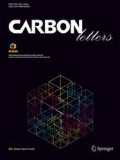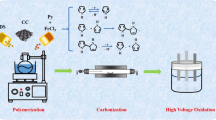Abstract
Engineering the microstructure of the carbonaceous materials is a promising strategy to enhance the capacitive performance of supercapacitors. In this work, nanostructured Black Pearl (1500 BP) carbon which is a conductive carbon being commercially used in printing rolls, conductive packaging, conductive paints, etc. is analyzed for its feasibility as an electrode material for Electric Double-Layer Capacitors (EDLCs). To achieve that commercial Black Pearl (BP), carbon is treated with mild acid H3PO4 to remove the impurities and enhance the active sites by regulating the growth of agglomerates and creating micropores in the nano-pigments. Generally, the coalescence of nanoparticles owing to their intrinsic surface energy has tendency to create voids of different sizes that act like meso/micropores facilitating the diffusion of ions. The electrochemical performance of BP carbon before and after chemical activation is investigated in aqueous (H2SO4, KOH and KCl) and a non-aqueous electrolyte (1 M TEMABF4 in acetonitrile) environment employing different electrochemical techniques such as Cyclic Voltammetry (CV), Galvanostatic charge/discharge (GCD) and Electrochemical Impendence Spectroscopy (EIS). The chemically activated BP carbon delivers the highest specific capacitance of ∼156 F g−1 in an aqueous electrolyte, 6 M KOH. The highest specific power, ~ 15.3 kW kg−1 and specific energy, 14.6 Wh kg−1 are obtained with a symmetric capacitor employing non-aqueous electrolyte because of its high working potential, 2.5 V.









Similar content being viewed by others
References
Michael MS, Kulkarni AR, Prabaharan SRS (2016) Design of monolayer porous carbon-embedded hybrid-LiMnPO4 for high energy density li-ion capacitors. J Nanosci Nanotechnol 16:7314–7324
Suganthi M, Charles J, Michael MS, Shree Kesavan K (2019) Enhanced specific capacitance of a novel ternary polypyrrole incorporated with prussian blue and mesoporous carbon black for high performance supercapacitor applications. Mater Res Bull 120:110587
Burke A (2000) Ultracapacitors: why, how, and where is the technology. J Power Sources 91:37–50
Khomenko V, Raymundo-Pinero E, Beguin F (2010) A new type of high energy asymmetric capacitor with nanoporous carbon electrodes in aqueous electrolyte. J Power Sources 195:4234–4241
Frackowiak E, Abbas Q, Beguin F (2013) Carbon/carbon supercapacitors. J Energy Chem 22:226–240
Kim JH, Nam KW, Ma SB, Kim KB (2006) Fabrication and electrochemical properties of carbon nanotube film electrodes. Carbon 44:1963–1968
Prabaharan SRS, Vimala R, Zainal Z (2006) Nanostructured mesoporous carbon as electrodes for supercapacitors. J Power Sources 161:730–736
Prabaharan SRS, Anslin Star R, Kulkarni AR, Michael MS (2015) Nano-composite LiMnPO4 as new insertion electrode for electrochemical supercapacitors. Curr Appl Phys 15:1624–1633
Shree Kesavan K, Surya K, Michael MS (2018) High powered hybrid supercapacitor with microporous activated carbon. Solid State Ion 321:15–22
Stoller MD, Park S, Zhu Y, An J, Ruoff RS (2008) Graphene-Based Ultracapacitors. Nano Lett 8:3498–3502
Geng X, Li L, Li F (2015) Carbon nanotubes/activated carbon hybrid with ultrahigh surface area for electrochemical capacitors. Electrochim Acta 168:25–31
Mhamane D, Suryawanshi A, Banerjee A, Aravindan V, Ogale S, Srinivasan M (2013) Non-aqueous energy storage devices using graphene nanosheets synthesized by green route. AIP Adv 3:042112
Michael MS, Prabaharan SRS (2004) High voltage electrochemical double layer capacitors using conductive carbons as additives. J Power Sources 136:250–256
Wahid M, Puthusseri D, Phase D, Ogale S (2014) Enhanced capacitance retention in a supercapacitor made of carbon from sugarcane bagasse by hydrothermal pretreatment. Energy Fuel 28:4233–4240
Xing W, Qiao SZ, Ding RG, Li F, Lu GQ, Yan ZF, Cheng HM (2006) Superior electric double layer capacitors using ordered mesoporous carbons. Carbon 44:216–224
Cao W, Yang F (2018) Supercapacitors from high fructose corn syrup-derived activated carbons. Mater Today Energy 9:406–415
Acknowledgements
The authors wish to thank the management of SSN College of Engineering, Kalavakkam, for the financial support provided in the current research work.
Author information
Authors and Affiliations
Corresponding author
Ethics declarations
Conflict of interest
The authors attest that they have no conflict of interest.
Additional information
Publisher's Note
Springer Nature remains neutral with regard to jurisdictional claims in published maps and institutional affiliations.
Rights and permissions
About this article
Cite this article
Samynaathan, V., Iyer, S.R., Kesavan, K.S. et al. High-performance electric double-layer capacitor fabricated with nanostructured carbon black-paint pigment as an electrode . Carbon Lett. 31, 137–146 (2021). https://doi.org/10.1007/s42823-020-00159-5
Received:
Revised:
Accepted:
Published:
Issue Date:
DOI: https://doi.org/10.1007/s42823-020-00159-5




